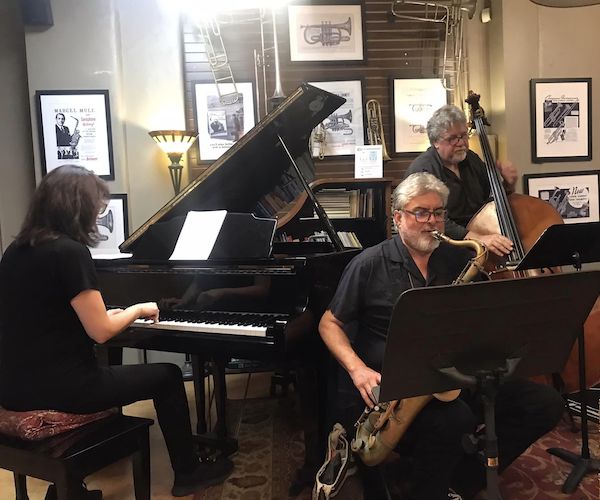Concert Review: The High Standards of Michael Formanek’s Elusion Quartet
By Jon Garelick
To hear free music so beautifully contained and expressed in such inventive forms isn’t unheard of (Henry Threadgill? Vijay Iyer? Wadada Leo Smith?). But bassist Michael Formanek has his own way.

(l to r) Pianist Kris Davis, saxophonist Tony Malaby, and bassist Michael Formanek in action at Boston’s Virtuosity Musical Instruments. Photo: Noah Schaffer
Sometimes, when writing preview blurbs for the Arts Fuse and other publications, I worry about overselling something, almost apologetically (“I know it’s free jazz, but please go!”).
That wasn’t the case on Wednesday (September 14) at Boston’s Virtuosity Musical Instruments, where bassist Michael Formanek’s Elusion Quartet held forth for about an hour with music that was captivating at just about every turn. The quartet — which has only one album to its name, 2018’s Time Like This — boasts the kind of crew that could have easily gotten away with an hour of free blowing: Formanek with saxophonist Tony Malaby (who organized the event), pianist Kris Davis, and drummer/vibraphonist Ches Smith.
As a few audience members gathered on Huntington Avenue in the afterglow of the show, we compared notes about what had made it all so moving. For one, this was neither a free jam nor one built on ready-made material (“two blues, two standards, and two originals based on ‘Rhythm’ changes,” to paraphrase Harvey Pekar’s formulation of a rote jazz set). Formanek had composed eight new pieces (the show was a kind of warm-up for a planned October recording session, he told me later). Do the math: those are relatively short tunes. Each was distinctive, with its own unusual form and procedures. There weren’t a lot of solos per se. Rather, there was a lot of four-way counterpoint with alternating written and improvised passages. Sometimes two players would vamp together while the other two improvised freely. Just when the ensemble seemed to be playing their collective freest, they’d follow some inaudible cue into a cadence and shift to another direction. And as someone on the sidewalk said (corroborating my hastily scrawled notes): they all had great endings.
The show really started with a bang, all four members slamming their instruments at once, Formanek pounding a single note in fast repetition, Malaby holding another in the upper register, Smith and Davis rumbling freely — the effect was of a high, sustained, ecstatic buzzing undergirded by that rumble.
My notes and memory of the “middle” of that first tune are sketchy, but it did provide the first startling formal move of the night: the ensemble broke for a closing section of quiet vibes, odd single-note patterns with Davis playing amusing counterpoint. (Given her musical contributions throughout the night and her demeanor behind the piano, Davis seems easily amused — and I mean that in a good way.) As I remember, the tune ended with Davis and Smith drifting off.
The second tune (they are as yet all unnamed, Formanek said), in a medium tempo, deployed a “straight” melody, mixing free and walking-swing rhythms. The third began with Formanek strumming a melody in what sounded like octaves over Smith’s free mallets before hitting an ostinato groove with a nice halting melody of short phrases by Malaby. And here Smith really came to the fore, his layered cross rhythms making me wonder how many rhythms he contained — every phrase, while hugging and sustaining the groove, exploding with inventive accents and fresh patterns. The tune finished with Smith’s quiet mallets and a final fading note from Malaby.
There was more — so much more: Davis opening up one tune with a kind of ascending Morton Feldman-ish three-chord pattern; Smith using two bass bows to scrape the edges of the bars on the vibes to get the sound of a glass harmonica and … something else; a playful steeplechase of a piece made up of short melodic fragments and syncopations with hard stops and rests; and another great groove tune with a meter that was as tantalizing as it was uncountable (a mix of 4/4, 5/4, and 6/4, Malaby later revealed).
The final piece of the night was the straightest: a flowing, long-phrased melody, stated in unison by piano and tenor over an ostinato groove, with actual solo sections (and subsequent applause) for bass, piano (Davis at her most boppish), and tenor, and witty a 1-2 coda.
To hear free music so beautifully contained and expressed in such inventive forms isn’t unheard of (Henry Threadgill? Vijay Iyer? Wadada Leo Smith?). But Formanek has his own way. His The Distance (ECM, 2016) was a typical Formanek surprise: we knew the bassist as a standout collaborator in small groups, but who knew that his first recording of big band compositions would not only be one of the best of that year but of any orchestral jazz being recorded? He appears in Boston maybe a couple of times a year, with players like Tim Berne or the band Thumbscrew. We’re fortunate that in February he’ll be returning to New England Conservatory to work with pianist Frank Carlberg. And there is that next Elusion Quartet record to look forward to.
In the meantime, Malaby is now living here, teaching at Berklee, as is Davis, and Malaby is organizing more shows with his and others’ bands, including several at the Lilypad.
I’ll be sure to recommend them. Without apology.
Jon Garelick is a member of the Boston Globe editorial board. A former arts editor at the Boston Phoenix, he writes frequently about jazz for the Globe, Arts Fuse, and other publications.
Tagged: Ches Smith, Jon Garelick, Kris Davis, Michael Formanek, Michael Formanek Elusion Quartet, Tony Malaby
